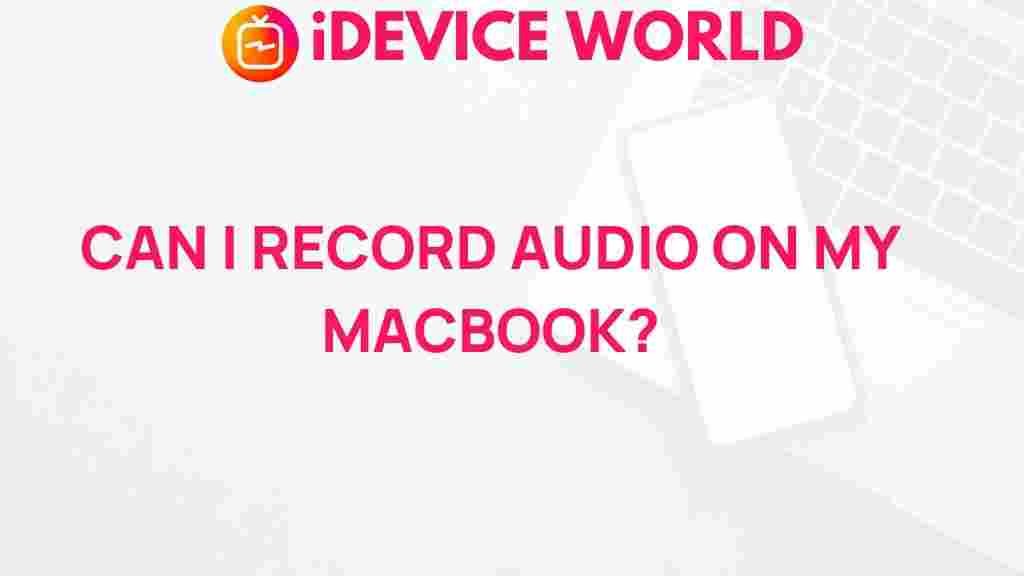Unleashing the Hidden Audio Recording Capabilities of your MacBook
In today’s digital age, audio recording has become an essential skill for many professionals and enthusiasts alike. Whether you’re a podcaster, musician, or simply looking to capture sound for personal use, your MacBook is equipped with powerful audio recording capabilities that often go unnoticed. This article will guide you through the process of uncovering these hidden features, optimizing your audio recordings, and troubleshooting common issues.
Why Use Your MacBook for Audio Recording?
The MacBook offers a range of features that make it an excellent choice for audio recording:
- High-Quality Microphone: Most MacBooks come with built-in microphones that deliver clear sound quality.
- User-Friendly Software: macOS includes several applications for recording and editing audio, such as GarageBand and QuickTime.
- Portability: The lightweight design of the MacBook allows you to record audio anywhere.
Getting Started with Audio Recording on Your MacBook
Before diving into the recording process, ensure your MacBook is equipped with the necessary software. Follow these steps to get started:
Step 1: Choose Your Recording Software
There are several applications available for recording audio on your MacBook:
- GarageBand: Ideal for musicians and podcasters, offering a range of tools for music production.
- QuickTime Player: A simple tool for basic audio recording and playback.
- Audacity: A free, open-source audio editing tool that offers advanced features.
Step 2: Set Up Your Recording Environment
To ensure high-quality recordings, choose a quiet space free from background noise. Here are some tips for setting up your environment:
- Find a room with minimal echo and sound reflection.
- Use soundproofing materials like curtains or carpets to reduce noise.
- Turn off any unnecessary electronics that may cause interference.
Step 3: Connect Your Equipment
If you’re using external microphones or audio interfaces, connect them to your MacBook via USB or the audio jack. Make sure your device is recognized by your operating system:
- Go to System Preferences > Sound > Input to select your microphone.
- Adjust the input volume to ensure optimal sound capture.
Recording Audio with Your MacBook
Now that your setup is ready, you can start recording audio:
Using GarageBand
To record audio in GarageBand:
- Open GarageBand and select Empty Project.
- Choose Microphone from the options and click Create.
- Press the red Record button to start capturing audio.
- Once finished, press the Stop button.
Using QuickTime Player
For QuickTime Player users:
- Open QuickTime Player.
- Go to File > New Audio Recording.
- Adjust the volume slider and click the red Record button.
- Click Stop when you’re done and save your recording.
Editing Your Audio Recordings
After recording, you may want to edit your audio to enhance quality:
- Trimming: Remove any unnecessary parts at the beginning or end of your recording.
- Adjusting Volume Levels: Ensure consistent audio levels throughout the track.
- Applying Effects: Use EQ, reverb, and compression to improve sound quality.
Troubleshooting Common Audio Recording Issues
Even with the best setup, you might encounter some issues while recording audio on your MacBook. Here are some common problems and solutions:
Issue 1: Low Audio Quality
If your recordings sound muffled or unclear, consider the following:
- Check your microphone placement; it should be a few inches away from your mouth.
- Make sure you’re using a high-quality microphone.
Issue 2: Audio Not Recording
If you can’t get any audio to record:
- Ensure your microphone is selected as the input device in your sound settings.
- Check for any software updates that may affect functionality.
Issue 3: Background Noise
To minimize unwanted background noise:
- Record in a quieter environment.
- Use noise-cancelling microphones if possible.
Advanced Recording Techniques
Once you’ve mastered the basics, consider exploring advanced techniques to elevate your recordings:
- Layering Tracks: Combine multiple audio tracks for a richer sound.
- Using MIDI: Incorporate MIDI instruments for music production.
- Field Recording: Use your MacBook to capture sounds in various environments for unique audio projects.
Conclusion
Your MacBook is a powerful tool for audio recording, equipped with features that cater to beginners and professionals alike. By utilizing the built-in applications, optimizing your recording environment, and troubleshooting common issues, you can unleash its full potential. Whether for music, podcasts, or personal projects, mastering audio recording on your MacBook opens up a world of creative possibilities.
For more tips and tutorials on using your MacBook, visit this helpful resource.
This article is in the category Guides & Tutorials and created by iDeciveWorld Team
